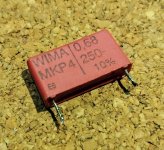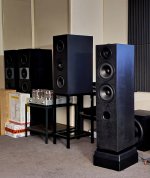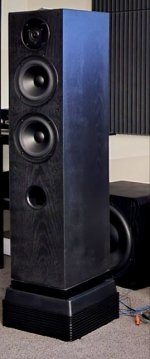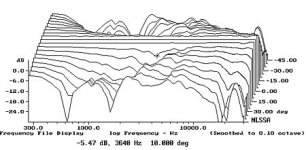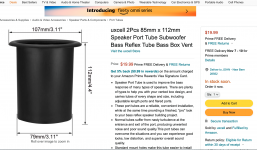Thanks Joe. You forgot to correct the ID in the notes column.Port typo re Port OD (outer diameter) corrected in https://www.diyaudio.com/forums/multi-way/97043-elsinore-project-thread-406.html#post6753170.
i just read about Waveguide and what i diggest that it's purpose is giving more capability to a driver xo to be cut lower. but in this Elsinore application for the tweeter is cut high (maybe very high) with 1.8uF. which is close to my super tweeter usage 1uF
is there any insight that i miss here?
is there any insight that i miss here?
i just read about Waveguide and what i diggest that it's purpose is giving more capability to a driver xo to be cut lower. but in this Elsinore application for the tweeter is cut high (maybe very high) with 1.8uF. which is close to my super tweeter usage 1uF
is there any insight that i miss here?
It maybe a misunderstanding in your terms but a waveguide does two things. Boosts low end and controls directivity. It allows you to cross higher electrically providing more protection. It also reduces off axis energy to match that dropping off from the crossed over driver meaning you get a smoother off axis transition
Thanks Joe. You forgot to correct the ID in the notes column.
Fixed! Again, may need to refresh cache.
---
i just read about Waveguide and what i diggest that it's purpose is giving more capability to a driver xo to be cut lower. but in this Elsinore application for the tweeter is cut high (maybe very high) with 1.8uF. which is close to my super tweeter usage 1uF
is there any insight that i miss here?
Actually, you said it yourself, there is much more to it.
For a start, this is an 8 Ohm tweeter, so we would expect it to be a bit lower to start as most are 4 Ohm.
The primary reason of using the waveguide in this instance, whilst there are others: LOW DISTORTION!
Indeed there is a choice to be made, use a waveguide to increase low end bandwidth (lower crossover point) or to lower distortion by not lowering the crossover frequency. This is the choice made here. Distortion is everything!
The 1.8uF value may seem to be low, but in fact is not. The output near 3KHz crossover frequency is around 5-6dB relative to near 10KHz. This means as we go lower in frequency there is an apparent gain down to the crossover point where we want to be around -2dB. So the smaller 1.8uF is required to EQ that response and hence we end up with a dramatically lower capacitance value that needs to have 3-4 times the reactance.
I have used another tweeter with its own waveguide in other designs. This is the Morel CAT-378 which is also used in models by Devore Speakers:
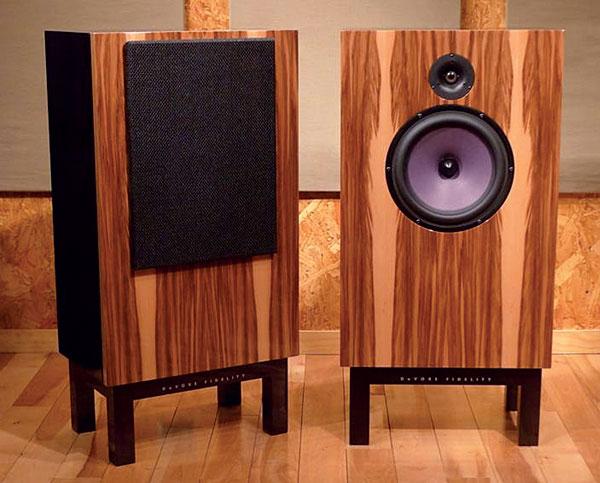
A bit plasticky though:

Now let us look at various on and of axis responses:\

You can see that gain, here between 8KHz down to 3KHz. Also, note that 5.6uF cap and note how it flattens out and the EQ it provides to the response.
You can also see that the response is -6dB @ 2kHz and so 5.6uF would be OK for that crossover. But a higher crossover the value would be rather smaller. But this waveguide is much smaller than the one we use in the Elsinores and hence the value of the cap becomes even smaller. Also, that this is an 8 Ohm load
There are other reasons of course why the waveguide is a good thing to do with directivity of course. But there is still another reason not so obvious. The reactance of 1.8uF is around 30 Ohm @ 3KkHz and that sits between the tweeter and the amplifier. The current of the amplifier has EQ applied to it so that the current phase angle into the capacitor is near zero, and guess what? Now from any amplifier, whether a voltage source or a current source, we have virtually achieved something very close to current drive. Can you hear this? Oh yes, it is part of the sauce that makes the Elsinores have a certain 'sound' that makes it so engaging to the ear. It is in fact low distortion.
Rant of the month is now over!
.
Last edited:
Any vertical and horizonal polar plots for the Elsinore, like these ones from Zaph?
In particular I'm interested in the vertical polars.
My guess is that the Elsinore's verticals won't look good - like most loudspeakers. Instead intended for a specific vertical window that's likely quite narrow though obviously still very usable.
Ah, John "Zaph" Krutke noted some tweeter tests I did a while back and I know that he is a SoundEasy software (which comes from Australia) and which I use myself, but I use it for modeling crossovers and of course, it has a huge suite of features. This is one of those that Zaph used and it is very impressive.
For reasons that can be complicated to explain, there are reasons I do and don't concern myself to these type of plots. For one, I don't actually have to measure it to know what I have. I know that might sound strange.
Certain types of crossovers gets the phase right (sums at -6dB) like LR types (a good thing). I am guessing, but the examples you give are LR-4 and that is not what I use and I have a number of reasons why.
But my approach, which is similar to Andrew Lipinski, is to take Dunlavy focussed array, where he, Dunlavy, used Butterworth (-3dB) crossovers, as a starting point. But Butterworth are 90 degrees off at the crossover point and this has problems with power response and narrow window that Dunlavy just didn't care about. Lipinski and I clearly do.
I am much more concerned about getting a focussed array working at -6dB and power response. But I know that if I get things right, the polar response will also be more than acceptable.
An impulse response like the one below will get what I need every time and sound better than Linwitch-Riley filters:
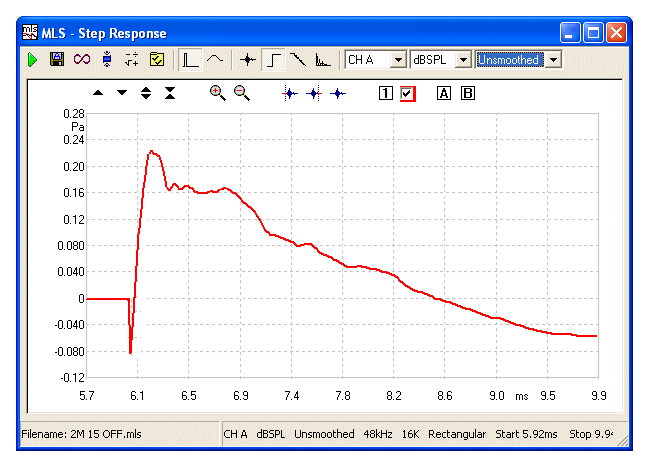
Why does this sound better than LR or Butterworth? I believe in time I will be able to explain this in greater detail than I have until now. It will indeed include distortion measurements. Yes, I am actually a guy who wants to know about bad (audible) distortions and less bad (like certain distortions are masked or they are more audible at certain sound levels than others). I am documenting these things as we go along.
Sorry for the second rant, I tried to keep it short, promise!
Hello Joe,
in post 4060 Part List for El-6 NRXC I see C5 0.68 µF. Is that a typo.
Not a typo as I have explained earlier. Just consider it a minor adjustment for flatter current phase angle above 10KHz. If you have the earlier value in Elsinores already built, then as I said, please don't be alarmed, just leave it as it is.
Joe,
C5 cap value for the Elsinore MK6 is 0.68 uF and your comment is "Use decent quality PP X2 type ok".
I have attached a picture of a 250V Wima MKP cap - will this work for C5 or you advise something else?
- Z
That is just fine. The PP X2 may just be easier for some to source as they are used as suppressor capacitors.
Ah, John "Zaph" Krutke noted some tweeter tests I did a while back and I know that he is a SoundEasy software (which comes from Australia) and which I use myself, but I use it for modeling crossovers and of course, it has a huge suite of features. This is one of those that Zaph used and it is very impressive.
For reasons that can be complicated to explain, there are reasons I do and don't concern myself to these type of plots. For one, I don't actually have to measure it to know what I have. I know that might sound strange.
Certain types of crossovers gets the phase right (sums at -6dB) like LR types (a good thing). I am guessing, but the examples you give are LR-4 and that is not what I use and I have a number of reasons why.
But my approach, which is similar to Andrew Lipinski, is to take Dunlavy focussed array, where he, Dunlavy, used Butterworth (-3dB) crossovers, as a starting point. But Butterworth are 90 degrees off at the crossover point and this has problems with power response and narrow window that Dunlavy just didn't care about. Lipinski and I clearly do.
I am much more concerned about getting a focussed array working at -6dB and power response. But I know that if I get things right, the polar response will also be more than acceptable.
An impulse response like the one below will get what I need every time and sound better than Linwitch-Riley filters:
Why does this sound better than LR or Butterworth? I believe in time I will be able to explain this in greater detail than I have until now. It will indeed include distortion measurements. Yes, I am actually a guy who wants to know about bad (audible) distortions and less bad (like certain distortions are masked or they are more audible at certain sound levels than others). I am documenting these things as we go along.
Sorry for the second rant, I tried to keep it short, promise!
Thanks Joe - this is very interesting, and of course there are lots of design decisions to make. Lovely step response.
I'd still be interested to know or see a vertical plot. I used to own LX mini's and their cardioid radiation was pretty much flat in horizontal and vertical to about 30 degrees, and circa 15kHz out. They there obviously limited in terms of SPL, but very satisfying 'sweet spot'.
I have also had speakers where you could hear lobing in the vertical response from seated to standing - I was really not keen - just want to make sure I'm committing to the right speaker before investing in a build.
Thanks.
I'd still be interested to know or see a vertical plot...
See the pic attached below. You can see the Elsinores which are Mk-3 boxes converted to Mk-6, the one of the Hamlets and finally an experimental 2-1/2 Way floor stander. Note how the box is elevated? This is because the tweeter actually needs to be set back 5 degrees (about 12mm), so to offset that, I had to raise the speaker temporarily so as to listen on the axis of the middle (midrange) driver. The front panel could have been slanted 5 degrees and then put back on the floor and listen at the height of the tweeter.
This is basically all you can do with the type of crossover used: Low 1st order but one that does NOT sum like a Butterworth (-3dB and significant loping), but 100% vector summing where you need it (-6dB and loping is not audible). The speaker is fairly tolerant to loping.
I will post some RTA measurements later. The area affected is just the area above the crossover as will be shown. These are actual measurements and not simulated.
As for the Elsinores, the situation is slightly different, here we have something more akin to a focussed array and both vertically and horizontally are symmetrical. Next time I have a pair in the system, I will do the same, but suffice to say that they are even better. The same applies to the Hamlets.
I have also had speakers where you could hear lobing in the vertical response from seated to standing - I was really not keen - just want to make sure I'm committing to the right speaker before investing in a build.
I honestly don't think it will prove to be a problem provided you step back 2 metres and stand up, the waveguide is angled 45 degrees, so if you can see the centre of the tweeter inside the waveguide? But let me say something, I often at night sit down on the floor in front of the couch and listen. Why I do that I am not sure, but I am well below the height of the tweeter and I still hear everything. I don't think so much about loping, but this is a focussed array with a wide window - and IMO they are the best sounding, period!
BUT:
There is also something else, the Elsinores as noted by many (and indeed this applies to speakers that have the above step response), that the sound seems to come out of the box in a way that LR speakers just don't. I have not myself heard the Lipinski L707 speakers (although I know others who have) and I can say for sure that they too are doing the same thing. Also, the Elsinores love tube amplifiers with output transformers, where this out-of-the-box character seems to be even better. I believe this is because output transformers are step-up current devices and I believe that how a speaker and amplifier dance together on the current side is one of the secrets that are still yet to be fully understood.
BTW, this out-of-box sound still happens with that experimental 2-1/2 Way speakers. And it does that right across a 3-person couch. My experience is that RTA measurements using two speakers and a lateral response across that three-seater varies by no more than 1dB, this is a parameter that I again value above the lobing issue.
Cheers, Joe
PS: If there are others who think differently to any of the above, they are welcome to disagree.
Attachments
Joe, I have been watching this Elsinore for years and already have the NRX required at half price $34 each. why i was asking for the waveguide is due to my wallet condition which does not agree yet for the purchase of D2608 tweeter and WG.
rough calculation : tweeter set maybe around $250 + WG $150 + 35% customs fee ended with $525.
it's almost doubled of what i paid for 8 NRX drivers
"experimental 2-1/2 Way floor stander."
i'm shocked to see you erperimental image, is it SB29RDC? i noticed the dimple tweeter
do you mind to share this experimental result for the crossover? I'd like to build it as my Elsinore alternative. not expecting a fully tested like Elsinore but this is something I can afford for the tweeter.
well hamlet i can build it for my 5 channel HT, might not need the extra 2 lower woofer for the bass because i already have 2 sealed subwoofer
rough calculation : tweeter set maybe around $250 + WG $150 + 35% customs fee ended with $525.
it's almost doubled of what i paid for 8 NRX drivers
"experimental 2-1/2 Way floor stander."
i'm shocked to see you erperimental image, is it SB29RDC? i noticed the dimple tweeter
do you mind to share this experimental result for the crossover? I'd like to build it as my Elsinore alternative. not expecting a fully tested like Elsinore but this is something I can afford for the tweeter.
well hamlet i can build it for my 5 channel HT, might not need the extra 2 lower woofer for the bass because i already have 2 sealed subwoofer
Attachments
I'd still be interested to know or see a vertical plot.
I have also had speakers where you could hear lobing in the vertical response from seated to standing - I was really not keen - just want to make sure I'm committing to the right speaker before investing in a build.
Below is Lipinski's vertical's taken by JA which are similar except that Joe's crossover is a bit higher and his drivers are a bit further apart (..which means the dip off-axis will be more pronounced and likely starting higher in freq.)
My guess is that you still have at least 10 degrees vertical before any difference and perhaps 20 degrees where you start into a moderately narrow-band -6db dip.
If you are particularly sensitive to this sort of result (and can't stay far enough away from them or listen within that vertical window) then I'd look elsewhere.
Attachments
Joe, I have been watching this Elsinore for years and already have the NRX required at half price $34 each... it's almost doubled of what i paid for 8 NRX drivers
Do they have any more. I would buy a truckload at that price.
"experimental 2-1/2 Way floor stander."
i'm shocked to see you erperimental image, is it SB29RDC?
Yes that is the tweeter and with the right crossover is not at all bad for a cheapie tweeter, most of which are to be avoided. That 2-1/2 Way is built into a pair of boxes that I acquired for free, but this is not ready to be published and at this stage there are no plans to develop it. Like I said, it is experimental.
If you are particularly sensitive to this sort of result (and can't stay far enough away from them or listen within that vertical window) then I'd look elsewhere.
Does anybody listen to speakers standing up? Later I will do at RTA measurement and look at -/+15 degrees, 30 degrees vertically, and post it.
EDIT: I remember Lynn Olson talking about walking around the room and hearing what he called "phasiness." Now that is something I don't want to hear and you (he?) won't.
.
Last edited:
Do they have any more. I would buy a truckload at that price.
Yes that is the tweeter and with the right crossover is not at all bad for a cheapie tweeter, most of which are to be avoided. That 2-1/2 Way is built into a pair of boxes that I acquired for free, but this is not ready to be published and at this stage there are no plans to develop it. Like I said, it is experimental.
Does anybody listen to speakers standing up? Later I will do at RTA measurement and look at -/+15 degrees, 30 degrees vertically, and post it.
EDIT: I remember Lynn Olson talking about walking around the room and hearing what he called "phasiness." Now that is something I don't want to hear and you (he?) won't.
.
I got 10 NRX on local distributor clearance sell, maybe it was not favourite on the market because it's the version with metal grill like accuton style. no common rite
I'll wait for your publish, mean while i think i will build Halcyon where i also have alpair 10p
i always seat in center position around 3m diagonal from L/R separated in 2.5m. my couch width is 2m but my position is always center, my children may seat beside me. so for me it always about on axis, no need for wide dispersion or vertical, no way i'll be standing listening to music or watch movie
i always seat in center position around 3m diagonal from L/R separated in 2.5m. my couch width is 2m but my position is always center, my children may seat beside me. so for me it always about on axis, no need for wide dispersion or vertical, no way i'll be standing listening to music or watch movie
I will in the near future show you a measurement that I use a "3-person couch test" and where the response across three persons varies by less that 1dB (in fact I have seen 0.5dB) across the couch for three persons. I will need to draw that up in a CAD program, but one of the things it proves is that speakers should be designed for off-axis and not for on-axis (even though we are allowed to take a look). If that sounds a bit confusing, it will be plain when it is prepared and shown properly. You will only get the proper strong centre image when sitting in the middle, you can't change the physics, but it still means that the right tonal balance and the impression of a nice soundstage and soundspace can be enjoyed by all three.
Now you may say that you don't need it, but here is the point: All three persons on the couch get something out of it. It just sounds better all-round, even if you are listening by yourself.
Port tube dimensions -- hard to find size -- HELP
Hey Joe,
I'm gathering parts for my Elsinore build and I've sourced everything except the port tubes. I'm having a hard time finding the correct size here in the US.
You specify 90mm dia x 100mm L with inside dia of 86mm.
The closest I can find is a set from Amazon that are tapered a bit:
Specification:
Mouting Diameter:85mm/3.34inches
Total Length:112mm/4.4inches
One End Diameter:107mm/3.11inches
The other end Diameter:79mm/3.11inches
Package Content:
2x Speaker Port Tube
Will these work? If not, do you or any DIY Audio member have a suggested source?
Thanks,
HappyJack
Hey Joe,
I'm gathering parts for my Elsinore build and I've sourced everything except the port tubes. I'm having a hard time finding the correct size here in the US.
You specify 90mm dia x 100mm L with inside dia of 86mm.
The closest I can find is a set from Amazon that are tapered a bit:
Specification:
Mouting Diameter:85mm/3.34inches
Total Length:112mm/4.4inches
One End Diameter:107mm/3.11inches
The other end Diameter:79mm/3.11inches
Package Content:
2x Speaker Port Tube
Will these work? If not, do you or any DIY Audio member have a suggested source?
Thanks,
HappyJack
Attachments
- Home
- Loudspeakers
- Multi-Way
- The "Elsinore Project" Thread
